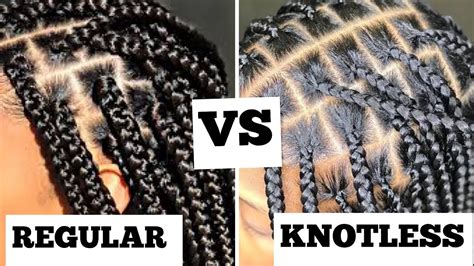Introduction
Protective hairstyles have become increasingly popular as a means to safeguard natural hair from damage while fostering length retention. Among the most coveted options are box braids and knotless braids, both of which offer distinct advantages and aesthetics. In this comprehensive guide, we delve into the intricacies of both styles, empowering you to make an informed decision that aligns with your hair’s needs and personal preferences.

Understanding Box Braids
Box braids, traditionally known as cornrows, are a timeless protective style characterized by their block-like appearance. Created by meticulously sectioning the hair into square or rectangular parts, each section is braided tightly from root to tip using synthetic or human hair extensions.
Advantages of Box Braids
- Versatile Styling Options: Box braids offer a vast array of styling possibilities, from sleek ponytails to intricate updos, making them adaptable to various occasions and personal tastes.
- Long-Lasting Protection: Properly installed box braids can endure for weeks or even months, safeguarding natural hair from breakage and environmental aggressors.
- Scalp Relief: Box braids alleviate tension on the scalp, providing respite from conditions such as traction alopecia caused by tight hairstyles.
Disadvantages of Box Braids
- Time-Consuming Installation: Box braids require meticulous sectioning and braiding, rendering the installation process time-consuming, often exceeding several hours.
- Heavy Weight: The weight of the extensions can burden the hair and scalp, potentially leading to discomfort or breakage if not installed with proper tension.
- Tightness: Box braids are typically braided tightly, which can result in some discomfort or scalp irritation for some individuals.
Knotless Braids: A Revolutionary Alternative
Knotless braids, a contemporary innovation in protective styling, emerged as a response to the drawbacks associated with box braids. This technique eliminates the knots traditionally used in box braids, replacing them with a continuous braiding motion that seamlessly fuses the natural hair with the extensions.
Advantages of Knotless Braids
- Reduced Tension: The lack of knots significantly reduces tension on the hair and scalp, minimizing the risk of breakage and discomfort.
- Lightweight: Knotless braids are noticeably lighter than box braids, making them more comfortable to wear and less likely to cause strain.
- Scalp Healthier: The continuous braiding technique promotes scalp health by distributing weight evenly and preventing friction that can lead to irritation.
Disadvantages of Knotless Braids
- Limited Styling Options: Compared to box braids, knotless braids offer fewer styling options due to their looser structure.
- Shorter Lifespan: Knotless braids generally have a shorter lifespan than box braids, typically lasting around 4-6 weeks.
- More Expensive: The specialized installation technique and increased time required for knotless braids typically lead to higher styling costs.
Comparative Analysis: Box Braids vs. Knotless
| Feature | Box Braids | Knotless Braids |
|---|---|---|
| Tension on Hair | High | Low |
| Scalp Comfort | Moderate | High |
| Styling Versatility | High | Moderate |
| Lifespan | Long | Moderate |
| Weight | Heavy | Light |
| Installation Time | Lengthy | Moderate |
| Installation Cost | Lower | Higher |
Considerations for Choosing the Right Style
When selecting between box braids and knotless braids, consider the following factors:
- Scalp Sensitivity: Individuals with sensitive scalps or a history of hair breakage may prefer knotless braids for their reduced tension and scalp comfort.
- Hair Type: Box braids are suitable for all hair types, while knotless braids are particularly beneficial for fine or fragile hair prone to breakage.
- Styling Preferences: If you desire versatile styling options and longevity, box braids may be a better choice. If comfort and scalp health are your priorities, knotless braids offer a more suitable alternative.
- Budget and Time Constraints: Knotless braids typically require a higher investment and longer installation time compared to box braids.
Tips and Tricks for Protective Styling Success
- Prep Your Hair: Before installing protective braids, thoroughly wash, condition, and deep condition your natural hair to enhance its strength and moisture levels.
- Choose Trusted Stylists: Seek out experienced stylists who specialize in protective styling and understand your hair’s specific needs.
- Minimize Tension: Ensure that your braids are installed with appropriate tension to prevent hair breakage and scalp discomfort.
- Moisturize Regularly: Keep your scalp and braids hydrated by applying oil or moisturizer to prevent dryness and itching.
- Protect at Night: Wear a satin bonnet or scarf while sleeping to reduce friction and maintain braid integrity.
- Plan for Removal: Schedule regular removal appointments to avoid prolonged strain on the hair and scalp.
Conclusion
Box braids and knotless braids each possess unique advantages and disadvantages. By understanding the nuances of both styles, you can make an informed decision that aligns with your hair’s needs and aesthetic desires. Whether you prioritize styling versatility, scalp comfort, or a balance between the two, both box braids and knotless braids offer effective protective style solutions to safeguard your natural hair and promote its health.
